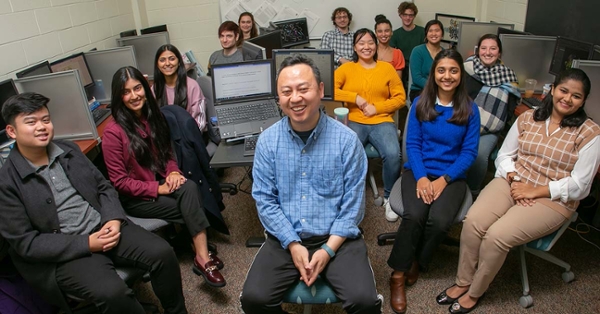Rowan team seeks cancer cure with help from a supercomputer
Rowan team seeks cancer cure with help from a supercomputer

Could a special-purpose supercomputer crack the code for curing cancer?
Dr. Chun Wu, associate professor in the departments of Chemistry & Biochemistry and Biological & Biomedical Sciences in the College of Science & Mathematics at Rowan University, will soon use the Anton 2 supercomputer to better understand the mechanisms behind a proven immunotherapy treatment used for certain blood cancers. What Wu discovers through these simulations could one day lead to new treatments for more common and hard-to-treat solid tumors often found in cancers of the lung, breast and prostate, among other types of cancers.
Anton 2 was developed by D. E. Shaw Research to run simulations of biomolecules and their interactions several orders of magnitude faster than was previously possible. The machine’s speed allows researchers to quickly gain insights into important biological processes. The company donates time on the machine for non-commercial use to U.S. researchers whose projects have been approved by the Pittsburgh Supercomputing Center (PSC) and a peer committee convened by the National Academies of Sciences, Engineering, and Medicine.
Wu and his team—including collaborators Dr. Nichole Daringer, assistant professor in the Department of Biomedical Engineering, and visiting professor Dr. Xiaoyang Mou in the Department of Chemistry and Biochemistry—have been awarded 460,000 molecular dynamics simulation units to be used on Anton 2, equaling 9.1 days on the machine. In comparison, Wu said, “using a graphics processing unit (GPU) to do the same task would take 10,000 GPU days.”
Wu’s work on the supercomputer will focus on an immunotherapy treatment called chimeric antigen receptor (CAR) T-cell therapy. CAR T-cell therapy begins with removing immune cells from the patient’s blood, then isolating and activating the T cells that naturally fight cancer. Scientists genetically engineer these living T cells in a lab to contain a tumor-specific antigen receptor. The modified T cells are then given to the patient by infusion. As these T cells replicate, they seek and destroy cancer cells more effectively than the patient’s naturally occurring T cells.
“CAR T cells may eradicate cancer cells, leading to a cure for cancer and possible long-term immunity that isn’t possible from existing treatments” for other types of cancers, Wu said.
Currently, there are six FDA-approved CAR T-cell therapies for the treatment of blood cancers—but none for solid tumor cancers. Treating solid tumors presents additional challenges compared to blood cancers, including limitations in reaching cells located toward the center of the solid mass and targeting tumor antigens that are often also found at low levels on normal cells.
“Developing CAR receptors with multiple antibodies and multiple signal domains might address these challenges by increasing selectivity, sensitivity and efficacy, allowing us to specifically direct the CAR T cells against tumor cells and spare healthy ones,” Wu said.
Running clinical experiments is a time-consuming and expensive endeavor, but simulations run on the Anton 2 supercomputer can greatly reduce the time and cost of developing drugs. Wu expects to begin publishing research findings related to this project by early spring and experimenting with the design of new CAR T cells before the end of 2023.
“Instead of blind-testing on tens of thousands of compounds in traditional experiment-based-only drug discovery, computer-aided drug design (or CADD) uses the structure of drug targets to identify drug candidates from a library of tens of millions in computers,” said Wu, who last used Anton 2 in 2020 to study the activation of a different receptor. “We believe that CADD is revolutionizing drug discovery.”